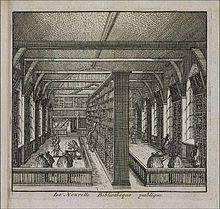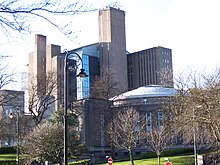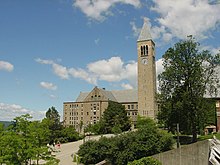DocTGarrett (talk | contribs) No edit summary |
DocTGarrett (talk | contribs) No edit summary |
||
| Line 12: | Line 12: | ||
[[Image:UrisLibrary24.jpg|right|thumb|Uris Library and [[McGraw Tower]], Cornell University]] |
[[Image:UrisLibrary24.jpg|right|thumb|Uris Library and [[McGraw Tower]], Cornell University]] |
||
[[Image:Univerzitetska bibloteka.jpg|thumb|[[Belgrade University Library]], a [[Carnegie library]]]] |
[[Image:Univerzitetska bibloteka.jpg|thumb|[[Belgrade University Library]], a [[Carnegie library]]]] |
||
An '''academic library''' is a [[library]] that is attached to academic institutions above the secondary level, serving the teaching and research needs of students and staff |
An '''academic library''' is a [[library]] that is attached to academic institutions above the secondary level, serving the teaching and research needs of students and staff.<ref> |
||
{{cite book | last=Hoare| first = Peter| title = Academic Libraries in International Encyclopedia of Information and Library Science, Ed. John Feather and Paul Sturges| publisher = Routledge| date = 1997| location = New York, New York| pages = 2| isbn = }}</ref>These libraries serve two complementary purposes: to support the school's curriculum, and to support the research of the university faculty and students.In process, the library plays a key role in the nation building process. |
{{cite book | last=Hoare| first = Peter| title = Academic Libraries in International Encyclopedia of Information and Library Science, Ed. John Feather and Paul Sturges| publisher = Routledge| date = 1997| location = New York, New York| pages = 2| isbn = }}</ref>These libraries serve two complementary purposes: to support the school's curriculum, and to support the research of the university faculty and students.In process, the library plays a key role in the nation building process. |
||
Revision as of 02:15, 17 August 2010







An academic library is a library that is attached to academic institutions above the secondary level, serving the teaching and research needs of students and staff.[1]These libraries serve two complementary purposes: to support the school's curriculum, and to support the research of the university faculty and students.In process, the library plays a key role in the nation building process.
The support of teaching requires material for class readings and for student papers. In the past, the material for class readings, intended to supplement lectures as prescribed by the instructor, has been called reserves. In the period before electronic resources became available, the reserves were supplied as actual books or as photocopies of appropriate journal articles. Traditionally, one copy of a book was made available for each 10 students — this is practical for large classes only if paperback copies are available, and the books reused from term to term.
Academic libraries must decide what focus they take in collecting materials since no single library can supply everything. When there are particular areas of specialization in academic libraries these are often referred to as niche collections. These collections are often the basis of a special collection department and may include original papers, artwork, and artifacts written or created by a single author or about a specific subject.
History
United States
The first colleges in the United States were intended to train members of the clergy. The libraries associated with these institutions largely consisted of donated books on the subjects of theology and the classics. In 1766, Yale had approximately 4,000 volumes, second only to Harvard.[2] Access to these libraries was restricted to faculty members and a few students: the only staff was a part-time faculty member or the president of the college. [3] The priority of the library was to protect the books, not to allow patrons to use them. In 1849, Yale was open 30 hours a week, the University of Virginia was open nine hours a week, Columbia University four, and Bowdoin College only three.[4] Students instead created literary societies and assessed entrance fees in order to build a small collection of usable volumes often in excess of what the university library held.[5]
Around the turn of the century, this approach began to change. The American Library Association was formed in 1876, with members including Melville Dewey and Charles Ammi Cutter. Libraries re-prioritized in favor of improving access to materials, and found funding increasing as a result of increased demand for said materials.[6]
Academic libraries today vary in regard to the extent to which they accommodate those who are not affiliated with their parent universities. Some offer reading and borrowing privileges to members of the public on payment of an annual fee; such fees can vary greatly. The privileges so obtained usually do not extend to such services as computer usage, other than to search the catalog, or Internet access. Alumni and students of cooperating local universities may be given discounts or other consideration when arranging for borrowing privileges. On the other hand access to the libraries of some universities is absolutely restricted to students, faculty, and staff. Even in this case, they may make it possible for others to borrow materials through inter-library loan programs.
Libraries of land-grant universities generally are more accessible to the public. In some cases they are official government document repositories and so are required to be open to the public. Still, members of the public are generally charged fees for borrowing privileges, and usually are not allowed to access everything they would be able to as students.
List of the largest academic libraries
A list of the top 20 academic libraries in North America by number of volumes[7]. [clarification needed]
- 1 Harvard University 16,250,117
- 2 Yale University 12,519,514
- 3 University of Illinois at Urbana-Champaign 11,686,060
- 4 University of Toronto 11,186,488
- 5 University of California, Berkeley 11,087,687
- 6 Columbia University 10,296,816
- 7 University of Texas 9,447,434
- 8 University of Michigan 9,175,102
- 9 Indiana University 8,723,253
- 10 University of Chicago 8,597,159
- 11 University of California, Los Angeles 8,393,910
- 12 Cornell University 8,141,781
- 13 University of Wisconsin 8,059,335
- 14 University of Washington 7,409,221
- 15 Princeton University 6,941,254
- 16 University of Alberta 6,890,679
- 17 University of Minnesota 6,877,699
- 18 University of North Carolina 6,526,824
- 19 Ohio State University 6,285,446
- 20 University of Pennsylvania 6,096,592
See also
- Academic journal
- Google Scholar and Academic Libraries
- Internet Search Engines and Libraries
- Research library
- Research Libraries Group
Notes and references
- ^ Hoare, Peter (1997). Academic Libraries in International Encyclopedia of Information and Library Science, Ed. John Feather and Paul Sturges. New York, New York: Routledge. p. 2.
- ^ Budd, John M. (1998). The Academic Library: Its Context, Its Purpose, and Its Operation. Englewood, Colorado: Libraries Unlimited. pp. 30–31.
- ^
McCabe, Gerard (1995). Academic Libraries: Their Rationale and Role in American Higher Education. Westport, Connecticut: Greenwood Press. pp. 1–3.
{{cite book}}: Unknown parameter|coauthors=ignored (|author=suggested) (help) - ^ Budd (1998), p. 34
- ^ Budd (1998), p. 34
- ^ McCabe (1995), pp. 1-3.
- ^ http://www.arl.org/bm~doc/arlstat08.pdf
Further reading
- Ellsworth, Ralph E. (1973) Academic library buildings: a guide to architectural issues and solutions 530 pp. Boulder: Associated University Press
- Taylor, Sue, ed. (1995) Building libraries for the information age: based on the proceedings of a symposium on The Future of Higher Educational Libraries at the King's Manor, York 11-12 April 1994. York: Institute of Advanced Architectural Studies, University of York ISBN 0904761495